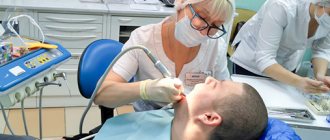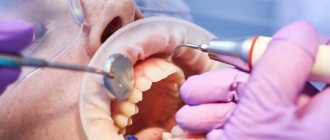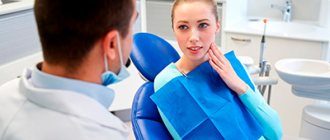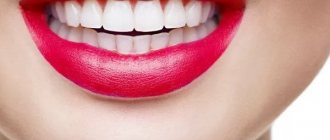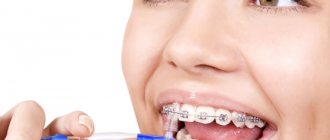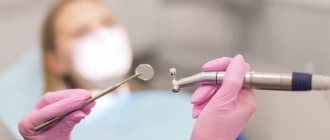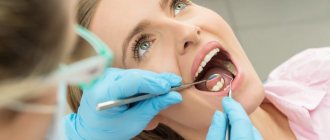A snow-white and healthy smile always leaves a pleasant impression of a person. But to maintain dental health, you need to brush your teeth thoroughly every day. Unfortunately, not everyone has enough time and patience to complete the entire range of hygiene procedures for oral care. But most people have the opportunity to have snacks throughout the day, drink sweet tea and coffee with baked goods, without thinking about the health consequences. All this leads to the formation of dental plaque, which many do not even try to fight, and if they do, it is done exclusively on their own. Is it possible to remove tartar at home? What modern way will return your smile to its former beauty in no time? Look for answers in our article.
Tartar: causes of appearance
Plaque forms on the surface of teeth in absolutely all people and is a soft biofilm consisting of food molecules and microorganisms. Soft plaque can be easily removed with a brush, floss and rinse. But in the absence of proper hygiene, it begins to thicken, darken, and after a few weeks mineralizes to the stage of stone.
In addition to untimely hygiene, the reasons for the formation of hard dental plaque can be:
- smoking
- excessive consumption of sugar and carbohydrates
- digestive diseases
- malocclusion
- use of poor quality hygiene products
- hereditary predisposition
What kind of improvised means did people use to clean teeth from tartar before the advent of the modern toothbrush? They used coal, iron, salt, tree bark, coconut oil, chili pepper, cloth and other available means.
Algorithm for the standard method of brushing teeth:
1. Divide the dentition into several segments: molars, premolars, anterior teeth.
2. Place the brush at an angle of 45 degrees to the surface of the teeth (dentitions are open).
3. Brush the teeth from the vestibular surface of the upper jaw on the left, performing 10 sweeping movements from top to bottom with the brush, then move on to all other segments.
4. Brush the teeth from the palatal surface of the upper teeth, moving in segments from left to right, making 10 sweeping movements on each one.
5. Brush the teeth of the lower jaw in the same sequence.
6. Brush all surfaces of the teeth with brush movements back and forth, 10 movements per surface.
7. Finish brushing your teeth with circular movements along the vestibular surface, grasping the teeth and gums.
Note. When performing sweeping movements with a brush, it is first placed at an acute angle from the surface to be cleaned, and then the brush is turned along its axis. During reciprocating movements, the brush is placed perpendicular to the surface to be cleaned. On the upper jaw, when cleaning the palatal surface of the front teeth, the toothbrush is placed with the handle down, and on the lower jaw, when cleaning the lingual surface, it is positioned upward. If the sequence of movements with a toothbrush is violated, plaque can be transferred into the interdental spaces.
Why is tartar dangerous?
Such a seemingly trivial problem as plaque and tartar often remains without proper attention. Just think, not entirely aesthetically pleasing. Your teeth don’t hurt, which means there’s nothing to treat. But this is for the time being.
Microorganisms living in dental deposits multiply quickly and in the process of vital activity they release acids that spoil the enamel and lead to inflammation of periodontal tissues. Itching, swelling, bleeding, pain in the gums, increased sensitivity of enamel, halitosis (bad breath), caries are the deplorable results of an indifferent attitude towards one’s health. But all this can be avoided if you clean your teeth from tartar in a timely manner.
For many, removing stones from teeth using improvised means seems obvious and easily accessible, especially now, when there is a lot of useful advice on the Internet for any problem. But the most dangerous thing in all this is that these recommendations are given by people who do not even have a basic medical education. These methods of cleaning tartar are, of course, absurd.
Let us present two folk remedies against tartar and explain from a medical point of view why they are ineffective.
Recipe one
Grate the black radish and add lemon juice to it. Brush your teeth with the resulting mixture in the morning and evening.
Doctor's explanation:
This elixir contains acid. Indeed, more than 25 years ago, before removing tartar from teeth with instruments, doctors used a special acid that softened it. But at home, even softened dental plaque cannot be removed using improvised means. But you can easily get increased sensitivity of the enamel as a complication.
Recipe two
Prepare a decoction of walnut bark. Wet your toothbrush with the broth and brush your teeth with it three times a day for 2-3 minutes.
Doctor's explanation:
Brushing your teeth 3 times a day for 2–3 minutes is a standard recommendation from dentists. But in terms of effectiveness, walnut decoction can be compared to drinking water. Try brushing your teeth without toothpaste - you will only be able to remove soft plaque. And neither a high-quality brush, nor a herbal decoction, nor even the most advertised toothpaste can cope with hard, mineralized deposits on the teeth.
From all of the above we draw a conclusion.
Universal tips for choosing a toothbrush
Both electric and manual toothbrushes come with different sized heads and different bristle configurations. Some studies have found that pointed or curved bristles are slightly more effective at removing plaque than flat brushes. If you choose a manual or electric toothbrush, choose one with soft bristles—bristles that are too hard are more likely to cause damage to your gums and enamel. To further protect your teeth while brushing, make sure the bristles on the toothbrush you choose have rounded tips.
If you are set on purchasing an electric toothbrush, pay attention to the two-minute timer. Research shows that most people brush their teeth for only about 45 seconds on average, so a timer may encourage you to brush longer. Some models also have timers that go off every 30 seconds to remind you to move to a different area of your mouth.
The best toothbrush head should allow easy access to all surfaces of the teeth and is usually small. Although there are larger toothbrush heads available, you may find that they are difficult to maneuver to clean certain hard-to-reach areas, such as the sides and backs of molars. The toothbrush should have a long enough handle so that you can hold it comfortably in your hand.
Ultrasound is a modern way to combat tartar
Preventive cleaning of teeth from stone with ultrasound has long been a mandatory procedure in civilized countries. In our country, there is no such practice yet, so patients are more negligent about their health and most often turn to the dentist when there are obvious health problems.
The procedure for cleaning teeth with an ultrasonic scaler in dentistry is carried out by a hygienist or periodontist. The specialist assesses the condition of the teeth and gums, excludes contraindications, selects the necessary attachment for the device and begins treatment.
In case of increased sensitivity of the enamel and deep cleaning of the subgingival area, the doctor may use local anesthesia - this will make the patient more comfortable during the procedure.
Under the influence of high-frequency ultrasonic vibrations, any dental deposits are destroyed, and pathogenic bacteria are destroyed from the surface of the teeth and from periodontal pockets. Ultrasonic cleaning lasts about an hour and ends with an enamel polishing procedure. You will not only see, but also feel the result: your teeth will become clean, smooth - and no hint of dark plaque.
In children, teeth cleaning from tartar and plaque with ultrasound is carried out after changing the primary bite to a permanent one and exclusively for medical reasons.
Despite the fact that ultrasonic cleaning is a safe procedure, it has a number of contraindications:
- general somatic diseases in acute form
- colds and ARVI
- infectious diseases
Ultrasound should be used with caution in patients with an artificial cardiac pacemaker.
Ultrasonic tartar removal is the most effective and fastest way to make your smile attractive again. For preventive purposes, this procedure is recommended to be carried out every six months, and for those who wear braces, even more often - once every 3 months.
Improper brushing of teeth
Let's admit it, we brush our teeth automatically. And we often do it wrong: we clean them with movements left and right, sherk-sherk. With this method of cleaning, soft plaque is transferred from the surface of the teeth to the interdental spaces and becomes clogged there. As a result, there is a danger of gum damage and the appearance of a wedge-shaped defect, especially on protruding teeth. A wedge-shaped defect is a lesion of a tooth in the area of contact with the gum. It looks like a step that resembles a wedge. The dimensions can range from barely noticeable to complete chipping in the future.
See what happens when we brush our teeth across their growth:
What to do to avoid the formation of tartar on your teeth
Take preventive measures:
- do not forget to brush your teeth thoroughly in the morning and evening
- purchase quality household hygiene products
- Don’t limit yourself to just one toothbrush: use flosses, irrigators, rinses
- avoid frequent snacking, balance your diet
- after eating, rinse your mouth with water
- less soft, high-calorie food, more solid and healthy food
- watch your health
- Visit your dentist and hygienist regularly
These simple tips will allow you to eliminate the first signs of dental plaque in time and reduce the risks of developing caries and periodontitis, which will be more difficult and expensive to treat.
Come to the Center for Modern Dentistry. Our specialists will teach you home hygiene techniques, tell you which brush and paste you need to use, and completely remove stubborn plaque in an effective and affordable way without harm to your health.
Cleaning hard to reach places
For high-quality and effective teeth cleaning, one toothbrush and toothpaste are not enough. How can you clean hard-to-reach places so that plaque does not gradually accumulate there?
To minimize the risk of dental caries in adults and maintain dental health, it is necessary to thoroughly brush your teeth twice a day. And in general everything seems clear, but how can you clean hard-to-reach places so that plaque doesn’t gradually accumulate there? Today, a dental hygienist from the CrocoDent clinic talks about this.
For high-quality and effective teeth cleaning, one toothbrush and toothpaste are not enough. Your smile can remain healthy if you take proper care of it. Our toothbrush can only handle three of the five surfaces - external (vestibular), internal (lingual/palatal) and chewing. There are also contact surfaces, each tooth has two of them. This is where your brush is powerless.
Interdental spaces are the most difficult to reach surfaces; plaque also accumulates in them and they require proper care. For high-quality care of the interdental space, we recommend using special brushes. They help effectively cope with plaque on the contact surfaces of teeth without damaging the enamel and gums. Interdental brushes vary in size, so please consult your hygienist before using them. Your dentist will measure the space between your teeth and suggest brushes that are the right size for you. It is enough to use the brush once a day.
Finish the brushing process with a mono-tuft brush. It allows you to clean each tooth with maximum quality in hard-to-reach places where a regular brush cannot reach. The use of a monotuft brush is permissible without toothpaste. It is better to use this brush twice a day - morning and evening.
Let an irrigator become an obligatory attribute of your daily hygiene. An irrigator is a device that delivers a powerful stream of water that can easily clean out food debris and plaque from the interdental spaces. In addition, a stream of water will provide a gum massage, which strengthens the walls of blood vessels, improves blood circulation and metabolism in the gums. We recommend using the irrigator 2 times a day.
Therefore, do not be afraid to slightly expand your range of oral care products, this will help you brush your teeth better and keep them healthy.
If you are in doubt about choosing a particular product, consult your dentist. Return to list of articles
